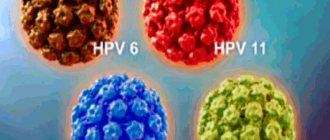Human papillomavirus (Latin: Human Papillomavirus, abbreviated as HPV or HPV) is the causative agent of warts on the skin and mucous membranes of the genital organs, i.e. condylomas and the cause of atypical changes in the mucous anogenital zone in women and men. More than 100 types of HPV are known, and it has been established that some of them infect a certain type of epithelium in women. The ability of oncotypes of the papilloma virus to provoke genital cancer poses a serious health hazard.
Symptoms of human papillomavirus (HPV)
Genital papillomavirus infection is caused by the human papillomavirus (HPV) and is characterized by damage to the skin and mucous membranes.
Symptoms of human papillomavirus (HPV):
- warts (genital warts, venereal warts, genital warts, exophytic condylomas),
- flat epithelial lesions , most of which are considered precancer.
The human papillomavirus infects the skin and mucous membranes, having a high affinity for the epithelial tissues of the genital organs, esophagus, anal canal and respiratory tract. There are more than 130 types of human papillomavirus, about 40 types of which can affect the anogenital area.
There are high- and low-oncogenic types of the virus, which differ in their ability to cause cervical cancer. Most cases of HPV infection are asymptomatic (subclinical forms or intraepithelial squamous lesions). A minority of them are represented by genital condylomas, characterized by exophytic growths of the epithelium. Lesions caused by oncogenic types are strictly associated with cervical neoplasia and, to a lesser extent, with neoplasia of the vagina, vulva, and perianal region (30-50%). 13 highly oncogenic types of HPV have been identified that cause cervical cancer. Other types of human papillomavirus play a role in the development of cancers of the skin, oropharynx, anus, and penis.
Cervical cancer is diagnosed on average 20 years after infection with a highly oncogenic type of HPV, but in recent years, faster malignancy has often been noted.
In 5-30% of women, several types of HPV are detected simultaneously. According to official statistics, approximately 50 thousand new cases of human papillomavirus infection are registered in the Russian Federation annually. According to international studies, the prevalence of HPV among young women reaches 30%.
Causes of the disease
- the main cause of urinary tract papilloma is human papillomavirus;
- favorable conditions for the occurrence and development of urinary tract papilloma are created with a significant decrease in the body’s defenses;
- sexually transmitted diseases play an important role;
- bad habits (alcohol, smoking);
- taking oral contraceptives.
More rare causes of urinary tract papilloma include:
- chronic kidney disease;
- taking certain medications;
- frequent visits to places with a high level of infection (swimming pools, saunas).
Clinical picture
It is believed that the incubation period before the clinical manifestation of HPV-associated diseases can be 1-8 months. Condylomas are exophytic formations, sometimes resembling cauliflower, on the skin, perineal and perianal mucosa, as well as on the mucous membranes. They can be multiple, asymmetrical and polymorphic. It is possible to change the size and number of genital warts, often resulting in the disappearance of the rash. In women, HPV most often affects the cervix, vagina, vulva and perianal area.
The classification of HPV-associated diseases is presented as follows:
- changes in the squamous epithelium of low malignancy (anogenital condylomas of the cervix, mild dysplasia);
- changes in the squamous epithelium of a high degree of malignancy (moderate and severe dysplasia and cancer);
- invasive cancer.
Subjective symptoms of HPV infection of the genitals and anal canal are usually absent. Characterized by a rapid increase in the size and number of genital warts, especially during pregnancy. Occasionally, patient problems such as bleeding, discharge and itching in the affected areas are identified.
Classification of the disease
- Bladder papilloma;
About 70% of all papillomas are localized in various parts of the bladder. Most often in the area of the triangle, then in the neck, dome of the bladder and lateral wall.
- Ureteral papilloma;
Can simulate ureteral colic with significant obstruction of the ureteral lumen.
- Renal pelvic papilloma;
Most often it is an accidental finding, as it develops asymptomatically for a long time.
- Urethral papilloma;
It is located in the urethra, so it is usually detected earlier than in other locations.
Cytological examination of material from the cervix
- Regular cytological examination allows for timely detection and treatment of cervical precancer.
- To detect cervical cancer and precancerous diseases, two methods are used: fixing a smear on a glass slide using an aerosol fixative (classic Pap test) and cytological examination of thin-layer smears of liquid preparations (in Russia this method is available in some laboratories).
- Cytologic examination of thin-layer smears of liquid preparations in women who are not at high risk is more sensitive than conventional smear-on-slide examination; such smears are less likely to be unusable. Regular cytological examination of cervical smears is necessary for all sexually active women (3 years after the onset of sexual activity, according to North American recommendations, and from the age of 25 years, according to European recommendations).
- There are recommendations from the Cervical Cancer Prevention Network, according to which, if immunity is normal, cytological examination should be performed annually or every 3-5 years.
- Patients with immunodeficiency, especially HIV-infected patients, require closer attention. Patient management is planned individually. Cervical cancer is more common in women living with HIV and those who have not been regularly screened.
How is HPV treated in women?
Combination therapy includes removal of formations and the use of various systemic nonspecific antiviral and immunomodulatory drugs. Doctors at the clinic consider preventive vaccination against HPV to be an effective method of preventing infection (especially if carried out before sexual contact of any kind) and it perfectly complements the main treatment regimen.
1. Local therapy
Aimed at eliminating the formations themselves and atypically changed epithelium. The most popular are cryodestruction, thermocoagulation, chemical coagulation, laser destruction, and removal of condylomas using radiosurgery. Most often, these methods eliminate the manifestations of HPV on the labia minora and single and multiple formations in the anus (in women and men). Each has a number of advantages and disadvantages. So, local treatment of papilloma virus is:
a) elimination of genital warts using one of the above methods. b) local impact on visible growths (ointments, suppositories). c) in the intralesional administration of drugs with antiviral activity.
2. General therapy
The second part of the therapeutic measures is to reduce the concentration of the human papillomavirus in the woman’s body. Its amount is directly related to the state of the body’s immunity - the better it is, the less virus there is. Therefore, the most promising way is to strengthen the immune system. The HPV treatment regimen includes the following:
a) elimination of concomitant infections; b) restoration of normal microflora of the vagina/intestines; c) correction/stimulation of immunity, HPV vaccination.
All these measures together make it possible to reduce the viral load in the body and prevent the emergence and progression of new formations.
3. Traditional medicine
Experiments on treating HPV at home are quite common. However, activities of this kind can be very dangerous: the results of the use of traditional medicine, various magical rituals and self-medication in general most often result in injuries, burns, rapid spread of condylomas to other areas and malignant degeneration of formations.
home
HPV Clinic
The World Health Organization (WHO) has developed recommendations on how to prevent and control HPV-induced genital cancer in women through vaccination and screening. In May 2022, WHO named the three main measures for the prevention of cervical cancer: vaccination against HPV, medical screening and timely treatment of background and precancerous cervical diseases.
Which doctor should I contact? In Moscow, for all questions related to HPV in women, you can contact our clinic on Kutuzovsky Prospekt. For you a complete list of necessary services, expert specialists for women and teenage girls. The doctor selects an HPV treatment regimen individually for each patient, based on diagnostic results and general health. Our gynecologists do not miss important symptoms of HPV infection during examination - condylomas and papillomas, which, unfortunately, often happens in other clinics. We have the technical capabilities for this. Do you want to make sure and see the finds for yourself? Please, we will show it on the monitor screen (read more in the material “Video colposcopy”).
Prices for HPV treatment
Basic range of clinic services for women:
✘ Appointment with a doctor with examination for HPV - 2500 ₽; ✘ HPV treatment (price for prescription regimen) - 3000 ₽; ✘ Consultation with a teenage doctor - 2500 ₽; ✘ High-risk HPV types - from 650 ₽; ✘ Analysis for the number of HPV oncotypes - 950 ₽; ✘ Colposcopy/vulvoscopy - 1500 0 ₽; ✘ Digen test (HPV DNA set) - 6200 ₽; ✘ Panavir dropper (with placement) - 5500 ₽; ✘ Allokin Alpha injection (with injection) - 3500 ₽; ✘ Taking a smear for human papillomaviruses - 450 rubles.
Given the widespread prevalence of the disease, doctors treating HPV recommend that both women, girls and adolescents contact and be tested for their presence.
Treatment of anogenital warts
Genital warts are characterized by a persistent recurrent course, but in 90% of patients they completely resolve without treatment within 2 years, especially at a young age due to cellular immunity. HPV lesions of the cervix resolve in 90-95% of cases. However, the disappearance of condylomas does not mean the complete elimination of the human papillomavirus. Regardless of the treatment regimen, in 20-30% of cases, condylomas reappear in the same areas or in other places. All treatment regimens lead to the development of local skin reactions, which usually require a reduction in the intensity of treatment.
Treatment methods:
- used by patients independently (imiquimod, podophyllotoxin are applied to the rash);
- used by a doctor: cryodestruction (can be used during pregnancy),
- dichloroacetic or trichloroacetic acid (can be used during pregnancy),
- solcoderm (mixture of acids),
- fulguration, destruction by electric current, carbon dioxide laser, surgical treatment.
Treatment of sexual partners in the absence of symptoms is not indicated.
HPV infection in children and pregnant women
During pregnancy, a Pap test is part of routine monitoring. Particular attention in pregnant women with HPV infection is paid to vaginal sanitation and correction of microbiocenosis. If condylomas are an obstacle to the birth of a child, a caesarean section is performed. In 50% of cases, condylomas that appear during pregnancy disappear within 3 months after birth. If genital warts are detected in children over 18 months (especially over 2 years of age), sexual abuse should be excluded.
Further tactics
Cystoscopy is an outpatient procedure, so the patient can return to their normal lifestyle on the same day. Within 1-3 days after the endoscopic examination, increased frequency of urination and the appearance of unpleasant sensations in the form of stinging are possible. This is due to direct trauma to the sensitive mucous membrane of the urethra and bladder during the procedure. The mucous membranes have a high regenerative ability and quickly heal on their own. During the first day after removal of polyps, a slight admixture of blood in the urine or mucous-bloody discharge from the urethra may appear.
After polypectomy, the patient is recommended to undergo a routine medical examination. Its frequency is determined by the attending physician. As a rule, after cystoscopy, the doctor prescribes a control test of blood and urine for the patient. After 6-12 months, you should undergo a repeat endoscopic examination to exclude relapses and assess the condition of the bladder mucosa.
Book a consultation 24 hours a day
+7+7+78
Observation
- After the disappearance of genital warts, women continue to undergo regular cytological examinations of smears from the cervix (possibly with virus typing) annually.
- If changes are detected in cytological smears from the cervix, patients should be observed once every 6-12 months, depending on the situation, until the process is completely resolved.
- Women with oncogenic types of HPV must undergo cytological and colposcopic examination (if indicated, consultation with appropriate specialists and additional examination).
Primary prevention of HPV infection:
- Reducing risk factors by informing the population about methods of preventing STIs.
- Vaccination. HPV infection is characterized by the epitheliophilic nature of the virus, which does not penetrate the blood and does not cause an active reaction of the immune system.
- The vaccine has only a preventive effect and does not have a therapeutic effect.
- Gardasil is directed against four types of HPV (16, 18, 6,11). In the Russian Federation, this vaccine is recommended for use in girls and boys before the onset of sexual activity, starting at the age of 9 years, and in women up to 26 years195.
- The bivalent vaccine Cervarix is directed against HPV types 16 and 18. The use of this vaccine is allowed in girls from the age of 9 years and in women up to 25 years.
Vaccines are effective in preventing severe forms of precancer and cancer of the cervix, vulva and vagina, as well as exophytic condylomas (genital warts).
Using a condom reduces, although does not completely eliminate, the risk of HPV infection.
A significant risk factor for HPV infection is a large number of sexual partners.
Suspected risk factors for cervical cancer:
- smoking (including passive smoking);
- long-term use of oral contraceptives (more than 5 years);
- a large number of pregnancies;
- other STIs (caused by Chlamydia trachomatis, herpes simplex virus type 2, HIV);
- poor nutrition (especially those with low amounts of antioxidants in the diet);
- immunodeficiency (AIDS, organ transplantation, immunosuppressive therapy);
- a large number of sexual partners, early onset of sexual activity, sexual contacts with persons infected with HPV;
- genetic predisposition: polymorphism of some genes that encode proteins that regulate the cell cycle.
Secondary prevention of HPV infection includes screening the population in order to detect the disease at the precancer stage and its timely treatment.
Previous post When do the first signs of pregnancy appear?
Next entry How to calculate the calorie range
Kinds
In the vast majority of cases, benign epithelial growths are represented by two types: transitional cell and squamous cell. Transitional cell (urothelial) papilloma accounts for up to 4% of all bladder tumors. It is a papillary growth with loose connective tissue, inside of which there are tiny blood vessels. The neoplasm is covered with urothelium, lining the surface of the entire organ from the inside. Urothelial papilloma occurs in patients over 50 years of age. It has an extremely low risk of relapse and malignancy. The neoplasm is most often represented by isolated epithelial outgrowths on a thin stalk or a wide flat base, but it can also have a diffuse (scattered) location.
One of its morphological variants is submersible type papilloma. It has the same histological characteristics, but is located differently. The growth of the tumor occurs mainly in the thickness of the mucous membrane. Thus, the main part of the papilloma grows deeply into the wall of the bladder, and only a small exophytic component is located in the lumen of the organ. Papilloma of the submerged type occurs in less than 1% of cases and is usually observed in patients over 65-70 years of age. It is characterized by slow growth and a benign clinical course, rarely undergoing malignant transformation. Most of these neoplasms are solitary, localized in the area of the neck or Lieto's triangle of the bladder.
Squamous cell papilloma is a neoplasm regarding which there is still a lot of disagreement among clinicians and researchers. In some cases, benign epithelial growth has a high oncogenic potential. True benign squamous cell papilloma occurs in 2-3% of cases. It looks like a single delicate lint protruding into the lumen of the bladder. The growth is covered with unchanged urothelium, which contains no more than 6 layers of cells. A high risk of malignant transformation is indicated when the number of layers in the epithelial layer increases and cellular atypia appears.










